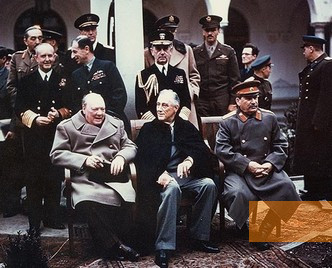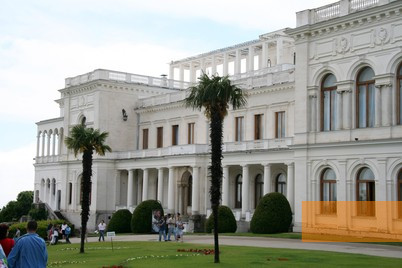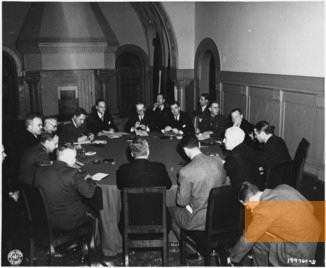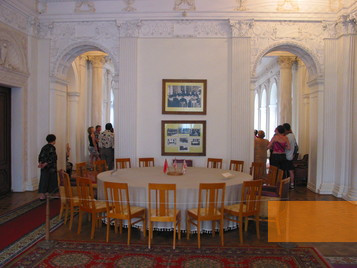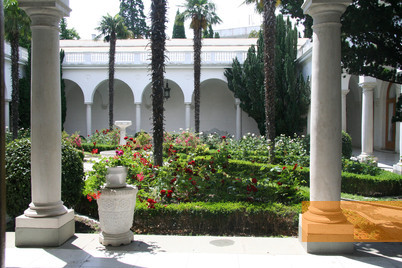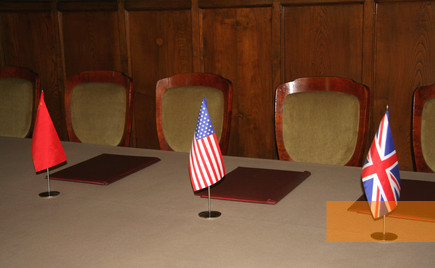A museum in the Livadia Palace in the coastal resort of Yalta in Crimea remembers the allied conference which took place in February 1945 for the purpose of discussing Europe's post-war reorganization.
After the USA entered the war in 1941 and the looming German defeat after the turning-point of war in winter 1942/43, the heads of government of the main Allies USA, Great Britain and Soviet Union met at several conferences from 1943 on. At these meetings first and foremost the post war status of Germany and the Eastern European states was discussed. The second of these summits took place on Soviet territory, in the coastal resort of Yalta in Crimea. From February 4 – 11, 1945 the heads of state and government Winston Churchill, Franklin D. Roosevelt and Joseph Stalin met at the Livadia Palace in Yalta, the former summer residence of the last Russian tsar. There the Allies decided principally to divide Germany after the war but didn't yet agree on borders. Most important topic on the agenda was Poland's future: The Allies adopted the shift of the Polish border to the West following the Curzon Line. This line from Hrodna (polish: Grodno) via Brest to Przemyśl had already been suggested as the Eastern border of Poland in 1919. Poland would receive territorial compensation in the North and West at the expense of the German Reich. Moreover, Churchill, Roosevelt and Stalin agreed on the founding of the United Nations and the Soviet Union agreed to enter the fight against Japan after the German capitulation. Although the interests of the three powers were too diverse to bring about concrete results regarding Europe's territorial reorganization, the negotiations boiled down to the Soviet Union trying to maintain and expand its influence on Eastern Europe.
The Yalta Conference of 1945 served to develop the principles for the reorganization of the European states after the end of World War II. Although no concrete resolutions were adopted, the conference nevertheless laid the foundation of further developments, such as the westward shift of Poland's border and the expulsion of millions of Germans from former Eastern territories as well as the relocation of millions of Poles from today's Ukraine. It also became apparent that the Soviet Union would bring the occupied Eastern European countries under its influence.
A first summer retreat for the Russian royal family was built in 1862 in Yalta or, to be more precise, in the suburb of Livadia. After the building had to be demolished because of severe groundwater damage, Tsar Nicholas II (1868 – 1918) had today's »White Palace« built in 1910.
In 1974 US president Nixon wanted to see the venue of the Yalta Conference during his official state visit to the Soviet Union. On this occasion a museum was established on the ground floor of the Livadia Palace, dedicated to the 1945 conference. In independent Ukraine after the collapse of the Soviet Union the upper floor with the former tsar's chambers were made accessible to the public. After the illegal Russian annexation of the Crimean Peninsula, the museum is still open. It is regularly host to special exhibitions and events with reference to the Yalta Conference, but also to the history of both world wars and to the Romanov dynasty.
In 1974 US president Nixon wanted to see the venue of the Yalta Conference during his official state visit to the Soviet Union. On this occasion a museum was established on the ground floor of the Livadia Palace, dedicated to the 1945 conference. In independent Ukraine after the collapse of the Soviet Union the upper floor with the former tsar's chambers were made accessible to the public. After the illegal Russian annexation of the Crimean Peninsula, the museum is still open. It is regularly host to special exhibitions and events with reference to the Yalta Conference, but also to the history of both world wars and to the Romanov dynasty.
- Name
- Liwadizkij Dworec-Muzej
- Address
-
ul. Baturina 44-а
Jalta - Web
- http://ливадийский-дворец.рф
- livadia-palace@mail.ru
- Open
- Daily 10 a.m to 4 p.m.
- Possibilities
- Permanent exhibitions, conference rooms, libraries, park, temporary exhibitions


